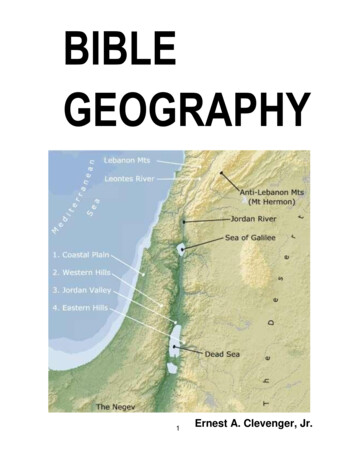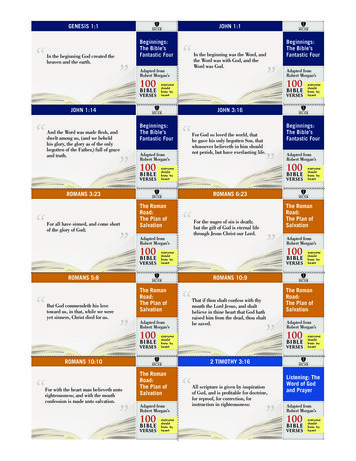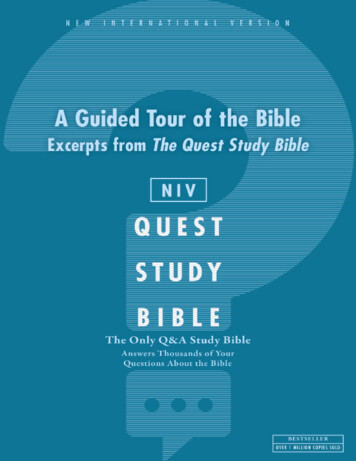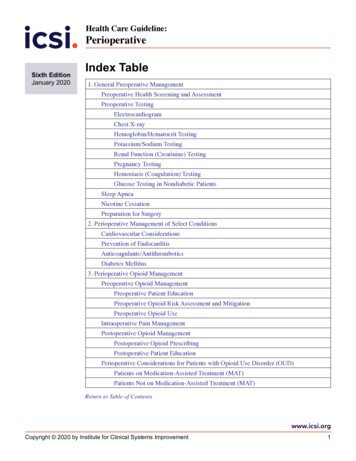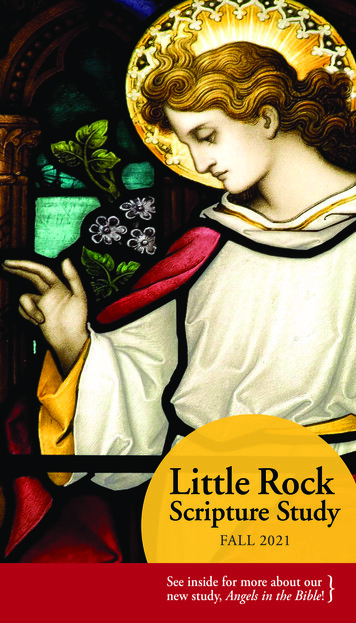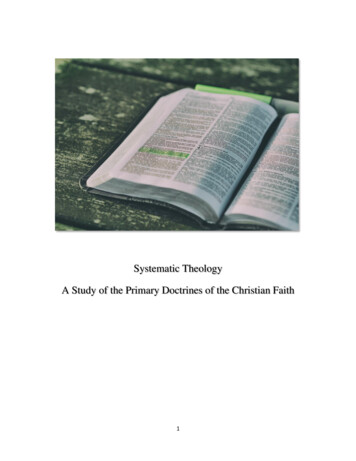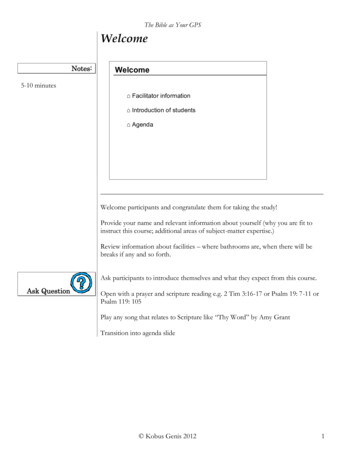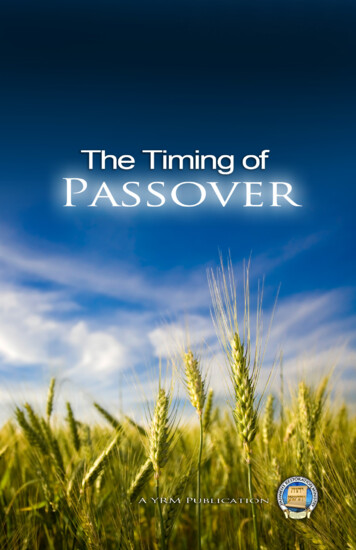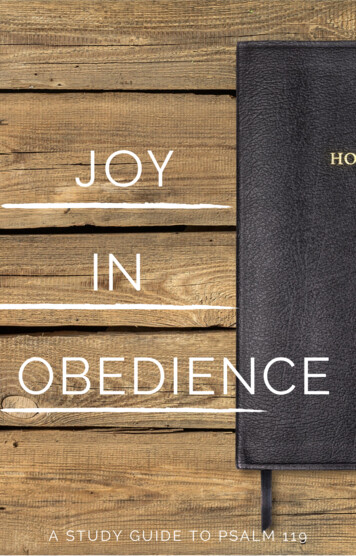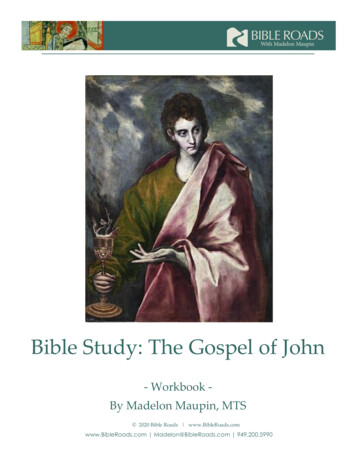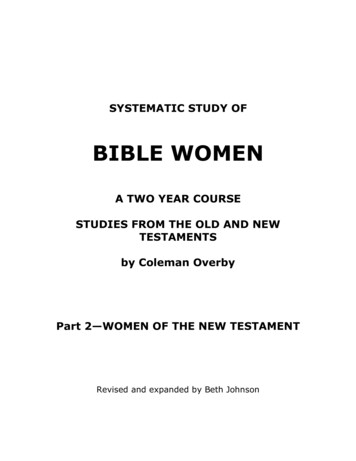
Transcription
SYSTEMATIC STUDY OFBIBLE WOMENA TWO YEAR COURSESTUDIES FROM THE OLD AND NEWTESTAMENTSby Coleman OverbyPart 2—WOMEN OF THE NEW TESTAMENTRevised and expanded by Beth Johnson
Dedicated to all women who study to show themselvesapproved unto God—1 Tim. 2:15“Grace is deceitful, and beauty is vain; But a womanthat feareth Jehovah, she shall be praised. Give her ofthe fruit of her hands; And let her works praise her inthe gates” (Prov. 31:30, 31).2
JUST A WORD PLEASE!This fourth edition of Bible Women is marked by many radical changes from the firstthree in the series. These changes will be noted:1) All characters studied are placed under the Period of Bible History, to which theybelong. Every lesson displays these headings: The Period of History, the time of it,the scriptures covered by it, and the Dispensation of Time. In the New Testament,the Periods of Life of Christ, and the Divisions of Acts are followed with the sameconsistency. At a glance, the teacher and student may recognize the Period of BibleHistory and the characters who lived at that time.2) A chart featuring these divisions is included in the book.3) With rare exceptions, all characters are arranged chronologically.4) The questions are often recast, to clarify the meaning, and to provoke thought.5) Where differences of opinion might appear, secondary arguments have beenpresented as well. These are presented along with the original questions.6) Many of the minor persons, mentioned in the first edition were omitted in the second,but they have been included again here. Therefore the study will take longer than ayear.7) An addendum to lesson 22 has been added to give researched notes to studentsand teachers because of the controversial nature of some of the questions.This revision is a mite of gratitude for the gracious and extensive reception of previouseditions. Its growth in popularity demanded the best the author could give. No effortshave been spared to make it the best. It is intentionally different from any other courseof study and fills a niche in the walls of Bible Study, not occupied by any other outline,used by the churches of the Lord Jesus Christ. It should give the users an insight to theBible never before realized. It is therefore sent forth with a prayerful hope that both theteacher and student will be richly blessed in their quest for His “unsearchable riches.”SUGGESTIONS FOR TEACHERS1) Prepare your lesson well. It will add interest and zest to the class, and it will gain theconfidence and respect of the pupils.2) Have a certain time to begin and close the lesson. Nothing helps quite as much asdoing things on time and with regularity.3) Make assignments to the students of the questions starred (*); these assignmentsare to be related in story form. This saves time, aids in covering the lessons, andbreaks the routine of the recitation.4) With the students, memorize the periods of Bible History and the BibleDispensations.5) Have frequent drills on the Periods of History and of the characters studied. This willaid the memory and add life to the course.6) Do not argue or permit arguments in the class. This is the surest way to kill interest.Permit each lady to express herself freely and pass on to the next question.7) Do not do all the talking; this is not a lecture course. Solicit the fullest cooperation ofall.3
INDEX OF NEW TESTAMENT CHARACTERSSTUDIEDLesson numbers follow each name included so far.Since this is a work in progress, please be patient until lessons forWomen of the New Testament are finished.Anna, a prophetess (NT 4)Apphia, a faithful Sister ()Bernice, daughter of Herod Agrippa ()Candace, Queen of Ethiopia ()Certain woman, an Ehusiast ()Chloe, of Corinth ()Claudia, a faithful Sister ()Damaris, a believer in Athens ()Daughters of Jerusalem (NT 16)Daughters of Philip, prophetesses ()Dorcas (Tabitha), a disciple at Joppa ()Drusilla, daughter of Herod Agrippa ()Elisabeth, wife of Zachariah (NT 1)Eunice, grandmother of Timothy ()Euodia, a member of the Philippian Church ()Herodias, wife of Herod (NT 12)Jairus’ daughter (NT 10)Jezebel, a false prophetess ()Joanna, wife of Chuzas (NT 8)Julia, and the sister of Nereus ()Lois, mother of Timothy ()Lydia, first convert in Philippi ()Maid, with Spirit of Divination ()Maids of the court (NT 18)Martha, sister of Mary and Lazarus (NT 15)Mary Magdalene (NT 9)Mary of Jerusalem ()Mary of Rome ()Mary, mother of Jesus (NT 2, 3)Mary, sister of Lazarus and Martha (NT 14)4
Mary, wife of Clopas (NT 16)Mother of Rufus ()Paul’s sister ()Persis, saluted by Paul ()Peter’s Mother-in-law (NT 6)Phoebe, of Cenchreae ()Pilate’s wife (NT 18)Priscilla, wife of Aquila ()Rhoda, a maid of Mary, of Jerusalem ()Salome, daughter of Herodias (NT 12)Salome, wife of Zebedee ()Sapphira, wife of Ananias ()Sister of Nereus ()Susanna, who ministered unto Christ (NT 8)Syntyche, a member of the Philippian Church ()Tabitha (Dorcas), a disciple at Joppa ()Tryphosa, saluted by Paul ()Virgins, wise and foolish (NT 17)Widow of Nain (NT 6)Widow of the parable (NT 17)Widow who gave all (NT 18)Woman of long standing infirmity (NT 13)Woman of the parable of money (NT 17)Woman with an issue of blood (NT 11)Woman with seven husbands (NT 16)Woman, Her Rank with Men ()Woman, the adulteress (NT 13)Woman, the Canaanitish ()Woman, the Samaritan (NT 5)Woman, the sinful (NT 7)5
Our purpose is to identify and scrutinize the actions andcharacter traits of each woman as well as her position in thehome, family and the nation where she lived. We will also studyhow she carried out her duties as a servant of God or as anenemy of God. We will see how her life influenced those aroundher and particularly how she used that influence for good or evil.We cannot gainsay the fact that the women who weremothers, wives, sisters or daughters to their sons, husbands orfathers not only shared their experiences, but also influencedthem and others for good or evil. These women, great or lowly,should be studied in order to understand the complete Biblepicture.Individual lessons for SBW-NT (Part 1) are taken from abook by the same name, written by Coleman Overby—last printedin 1945 (now in the public domain). Because Overby’s bookcontains such extensive research, it has been the basis forseveral larger publications written by several modern dayauthors. However, rather than following those newer works, wefeel that our time would best be spent studying the original. Youwill not be expected to buy anything since the book is now out ofprint.My sincere hope in this lesson series is to provide more thanjust a cursory look at each personality in order to help uscompare the information we glean with God’s will for us asChristian women. We will attempt, in every case, to comparewhat actually happened with what should have happened.“Now we have received, not the spirit of the world, butthe spirit which is of God; that we might know the thingsthat are freely given to us of God. Which things also wespeak, not in the words which man's wisdom teacheth,but which the Holy Ghost teacheth; comparing spiritualthings with spiritual.”(1 Cor. 2:12-13)His servant,Beth Johnson6
SYSTEMATIC STUDY OF BIBLE WOMENNew Testament WomenThe Fading Jewish AgePrior to the Birth of ChristRemarkable AnnouncementsLESSON 1PERIOD OF PRE-EXISTENCE(References in Luke)ELISABETH -- God is swearer; God is an oathNote that this name is spelled both with an ―s‖ or with a ―z‖ depending onthe source you use.1. During what time period did Elisabeth and her husband live? You mayneed to check the chart in the front of the book.2. Who was her husband, and what was his duty (1:5, 9)?3. Of what tribe were they (1:5)?4. Of what family was she (1:5; 1:65-66)?5. What is said of the model lives of these companions (1:6)?6. What disappointment had they shared (1:7)?7. What was the wonderful message to Zacharias (1:8-17)?8. Describe the child's life and mission (1:14-17).9. Give the name of the angel who announced the birth of John (1:19).10. How did the angel confirm his announcement to Zacharias (1: 18-23)?11. In fulfillment of the angel's words, what did Elisabeth say (1:24-25)?12. Retell Mary's visit to Elisabeth (1:39-45; 56).13. What was the age of these parents at the birth of John (1:7, 18)?14. At the birth of this special son, who rejoiced (1:58)?15. Recount the remarkable experiences in naming the child (1:59-66).7
16. Why was he to be called John (1:13, 60, 63)?17. When are neighbors ―neighborly‖ (Rom 12:15)?18. In circumcising the boy, what covenant was fulfilled (Gen 17:9, 12; Lev12:3)?POINTS TO CONSIDER:1. What lesson may be learned from Elisabeth’s happiness though "wellstricken in years?"2. How should old age be dignified (Prov. 20:29; 2 Cor. 4:16-18)?3. Tell of the great faith of Elisabeth during the dumbness of her husband(1:59-65)?4. Did her unselfishness find its way into the life of John (John 1:30; 3:30;Matt. 3:11)?5. Give the substance of Zacharias' prophecy (1:67-79; *vs. 76).6. What is said of John's growth physically and spiritually (1:80)?7. What did Jesus say of his greatness (Matt. 11:11; also Luke 1:15; Luke7:24-28; John 5:32-36)?8. Did Elisabeth fully cooperate with her husband in his life and his work(1:5-6)?9. Who was next to Jesus in making and baptizing disciples (John 4:1-2)?10.How did John lose his life (Matt. 14:1-13)?8
SYSTEMATIC STUDY OF BIBLE WOMENLESSON 2PERIOD OF PREPARATIONNew Testament WomenThe Fading Jewish AgeJesus’ Birth to His BaptismAbout 30 Years(References in Luke unless otherwise noted)MARY - THE MOTHER OF JESUS1. Who was Mary engaged to? How is she described (1:27)?2. Where did Mary live? Who was sent to her (1:26)?a. Briefly explain what denominational writers commonly refer to asthe Annunciation (1:28-38).b. How was Mary favored above all women (1:30-31)?c. How was she fully assured of the event (1:37)? Tell of herimplicit trust (1:37-38).3. Following the Annunciation, whom did Mary visit (1:39-40)?a. Reiterate the song of Mary; giving the substance of her praise(1:46-55).b. How long was she with Elizabeth (1:56)?4. What complications arose because she was found "with child‖ (Matt.1:18-20)?a. Under the Law, a breach of marriage contract incurred whatpenalty (Deut. 22:23-24)?b. What had Joseph planned to do (Matt. 1:19)?c. How did divine intervention remove all doubt Joseph might havehad?d. Tell of the angel’s visit to Joseph (Matt. 1:20-23).9
e. At this point, what prophecy was fulfilled (Matt. 1:23; Isa.7:14)?5. What did Joseph do in obedience to the angel’s message (Matt. 1:24)?a. What was briefly mentioned of his marriage?b. How was it unusual?6. Why were Mary and her husband to go to Bethlehem (2:1-4)?a. There was no necessity of Mary's going; why did she go (Mic.5:2)?b. What was her condition at this time (2:5-6)?7. Give a brief description of the birth. Why was the child "laid in amanger" and what was His clothing (2:7)?8. Describe the angelic announcement to the shepherds. What sign wasgiven and how were they to locate the child (2:8-14)?9. Now, tell of the shepherds’ visit (2:15-20).10. Who was deeply moved? What did she do (2:19)?11. Tell of the naming and circumcising of the child in Jerusalem (2:21).a. Why was He called "Jesus" (Matt. 1:21,23, 25)?b. Why did His parents offer the sacrifice of birds (2:24, Lev. 12:2,6-8)?c. When was the child presented to the Lord (2:22; Lev. 12:2-6)?d. How were the parents moved by the things spoken (2:33)?12.Give the main points of Simeon's blessing upon Mary (2:34-35).13.Who came "from the East" to see the child (Matt. 2:1-2)?a. What king was very disturbed by His birth and why (Matt. 2:34)?b. Narrate the visit of the Wise Men to see Jesus (Matt. 2:7-12).Where did they go later? Why?10
SYSTEMATIC STUDY OF BIBLE WOMENLESSON 3PERIOD OF PREPARATIONNew Testament WomenThe Fading Jewish AgeJesus’ Birth to His BaptismAbout 30 Years(References in Luke unless otherwise noted)MARY, THE MOTHER OF JESUS (continued)1. Draw a word picture of the experience of having to flee to Egypt (Matt.2:13-15).2. Tell of Herod's desperate effort to kill Jesus (Matt. 2:16-18).3. Tell of Joseph’s and Mary’s return to Israel (Matt. 2:19-23).a. Why did they withdraw into Galilee (Matt. 2:22)?b. Why did they finally settle in Nazareth (Matt. 2:23; Luke 2:39)?4. Joseph and Mary lost Jesus; tell of their anxiety (2:41-51).a. Where did they find Him? Was He really lost (2:46)?b. Tell of the child's obedience to His parents (2:51).c. What was said of Mary's thoughtful pondering (2:51)?d. In the meantime, what was said of the growth of the child (2:40;2:52)?11
5. Did Mary have other children; if so who were they (Matt. 13:55-56: Mark6:3)?a. How are people related to Christ today (Matt. 12:48-50)?b. How is obedience blessed, above blood ties (Luke 11:27-28)?6. Mary attended the wedding feast in Cana; retell the story (John 2:1-11).7. How did Jesus address His mother (John 2:4)?8. How did Jesus refer to his mother as he hung on the cross (John 19:2527)?9. Jesus went with Mary to what place after they left Cana (John 2:12)?10.Later, with whom did she come to see Jesus (Matt. 12:46)?11.Who informed Him of her presence and desire (Matt. 12:46-47)?12. What lesson did He now teach on divine relationships (Matt. 12:4850)?13.Who was with Mary at the cross (John 19:25)?a. What prophecy is fulfilled here (Luke 2:35)?b. To whom did Jesus commit His mother for protection (John 19:26)?c. We may speculate about the reasons Jesus gave His mother to theApostle instead of to one of his brothers, but do the scriptures saywhy?d. What did Jesus ask John to do (John 19:27)?12
14.With whom is Mary associated in prayer (Acts 1:12, 14)?15.As far as we know, where is the last mention of Mary?POINTS TO CONSIDER:1. Is there any evidence that Mary ascended to heaven without dying?2. Is there any evidence that she was sinless (1 John 1:8-10)?3. Can the doctrine of her Perpetual Virginity be true (Matt. 13:55-56: Mark6:3)?4. Should intercession in prayer be made through Mary (1 Tim. 2:5)?5. Should Mother's Day affect the Lord's Day?6. Is there any reason we should use the term "Mary, Mother of God?"7. Does the Bible use the term "Mary, the Magnificent"?8. Is the term Immaculate Conception found in scripture?13
SYSTEMATIC STUDY OF BIBLE WOMENLESSON 4PERIOD OF PREPARATIONNew Testament WomenThe Fading Jewish AgeJesus’ Birth to His BaptismAbout 30 Years(References in Luke unless otherwise noted)ANNA—grace (Greek form of the Hebrew name Hannah)1. Whose daughter was she? Of what tribe (2:36)?2. What was she (2:36)?3. How old was she and how long was she married (2:36)?4. How long had she been a widow (2:37)? This is a trick question.5. What was her continuous work? She is remembered for her devotion and piety(2:37).6. What special person was it her privilege to see (2:34, 38)?7. What was her attitude toward this event (2:38)?8. In what way could we compare Anna to Miriam. What were they both (2:36; Exod.15:20)?9. How does Anna compare to Phebe (Rom. 16:1-2).10. From Anna, what lessons can be learned about widows?11. Who are widows indeed (1 Tim. 5:3, 5, 9, 10)?12. What should be the attitude of aged women toward younger women (Tit. 2:4-5)?POINTS TO CONSIDER:1. Some ask, “If the priesthood belonged to men, why would Anna’s services benecessary?” What was her service? Was Anna a priest or a prophetess? Wasshe serving men or God?14
2. Since ANNA was of the tribe of Asher, what right did she have in the temple?Some have contended that from the time of Jeroboam, the apostate king, priestswere appointed from all tribes (I Kings 12:1, 31) and that was why she was there.Consider the three ideas below and then tell what is wrong with the aboveexplanation.a. Was she a priest(ess) or a prophetess?b. Could anyone prove she was in the Holy Place or the Holy of Holies?c. Into what part of the temple grounds were all tribes of Israel allowed to come?3. Notice that Joseph and Mary were of the tribe of Judah. Would Anna have had thesame right in the courtyard of the temple as did an Israelite from any tribe?Consider the following scriptures: 2 Chron. 26:16-21 (High priest in the Holy ofHolies); Heb. 9:6-7 (Any priest in the Holy Place): Heb. 7:14-15 (Jesus of the tribe ofJudah); Heb. 11:17; Exod. 28:1; Num. 18:7; Num. 3:9-10; Lev. 1:5, 8, 11.Remember: none of these people were Gentiles.4. How does Anna seem to demonstrate that there was a lingering hope in Israel forthe coming Messiah?5. Thus far, who has honored the Christ both in Bethlehem and in Jerusalem?6. What command of Titus did Anna fulfill (Tit. 2:3-5)?JUST FOR INTEREST SAKE SEE THE FOLLOWING STUDY:THE TEMPLE: A Place of Worship(Adapted from the Living Way STUDENT WORKBOOK)Matthew 21:12-17; Mark 11:15-19; Luke 19:45-48; and John 2:13-22Many years ago, before Christ came into the world, God provided more things forpeople to see when they worshipped Him. Burnt offerings, priests with beautifulclothing, the Ark of the Covenant, tables of stone with the Ten Commandments writtenon them, and other things helped people worship God. When the time came that Israelwas called out of slavery and was therefore God’s chosen people, they also had aspecial place of worship.In the early years of the nation of Israel, they were traveling around in the wilderness sothey needed a place of worship that could be carried from one place to another. Thiswas the tabernacle that you study about in the Old Testament. When the Jews reachedthe Promised Land and got a king, David prepared and Solomon built a beautifultemple.15
Solomon’s temple was planned somewhat like the tabernacle. There was an outercourt divided into two parts. The upper court for the priests and other worshippers hada brass altar and a brass sea standing on four groups of three oxen each and ten laversof brass.The temple was twice as long, broad, and high as the tabernacle. It was built of stonesand roofed and lined with cedar. The cedar of the whole house of both holy places was(1 Kings 6:21-22; 30; 2 Chr 3:7-8) overlaid with gold. The temple was divided into tworooms, the Holy Place and the Holy of Holies.The Holy Place had candlesticks, and tables. In the Holy of Holies were the altar ofincense and two cherubim with wings about seven and one-half feet long over the Ark ofthe Covenant. It was separated from the Holy Place by a curtain and by chains of goldand two doors of olive wood (1 Kings 6:31).This very beautiful temple was burned by Nebuchadnezzar’s general. UnderZerubbabel the Jews erected another temple after they came back from captivity.Herod renovated the temple so completely that it was called Herod’s temple. This wasthe one in existence when Jesus was on earth. The Ark of the Covenant was lost whenIsrael went into Babylonian captivity and so was not mentioned as being in any of thetemples after Solomon’s temple.The temple was a beautiful place—the most wonderful building in Israel and probably(according to Josephus and the Roman Emperor, Valentinus' son, Titus) in the wholeworld. Columns, gates, roof of cedar, floor of beautiful laid gold, precious stones (2Chro 3:6), and fine workmanship all combined to make it truly magnificent. Over thegates from the outer court of the Gentiles was inscribed, “Beyond this point none of theuncircumcised may pass, on pain of death.”Jesus told the woman of Samaria at the well that we are to worship in spirit and truthand not in a special place (John 4:20-24). Under Christ we do not depend on a physicalbuilding and there are only two things necessary that we see with our physical eyes.We can see people baptized and we see the emblems of the Lord’s Supper. Thespiritual temple today is one of several descriptions of the life of a Christian. Paul saidChristians are the temple of God (1 Corinthians 3:16). We are God’s building (1Corinthians 3:9-14; Ephesians 2:21, 22). Jesus confused his enemies by referring toHis body as a temple they would destroy and that He would raise it in three days (John2:19, 20).One of the first events in the life of Christ was His presentation in the temple (Luke 2:22,39). When He was 12, He stayed in the temple when His parents started home (Luke2:41-50). Twice He showed His zeal for God's temple against the people who did notrespect it and were using it to make money from worshipers. He drove out the cattleand overturned the tables of the money-changers (Matt 21:12: Mark 11:15).1 Kings 6:2116
21 So Solomon overlaid the house within with pure gold: and he made a partition by thechains of gold before the oracle; and he overlaid it with gold.1 Kings 6:2222 And the whole house he overlaid with gold, until he had finished all the house: alsothe whole altar that was by the oracle he overlaid with gold.1 Kings 6:3030 And the floor of the house he overlaid with gold, within and without.2 Chron 3:77 He overlaid also the house, the beams, the posts, and the walls thereof, and the doorsthereof, with gold; and graved cherubims on the walls.2 Chron 3:88 And he made the most holy house, the length whereof was according to the breadthof the house, twenty cubits, and the breadth thereof twenty cubits: and he overlaid itwith fine gold, amounting to six hundred talents. I remember reading about the Gentile partition wall and the women's partition in theAntiquities book of Josephus. But as far as it being in the Bible, I am pretty sure I don'tremember ever reading about it there.According to the historian, Josephus, the Gentiles were never allowed into the templeitself. They could only go up to a certain point in the court yard. Josephus reported thatwhen Titus Vespasian (70 A.D.) finally breached the wall and entered Jerusalem, manyof the last Jewish survivors were hiding in the Temple because they didn't think anyGentile would dare go past the "Gentile" wall. (They were mistaken, of course, as Titusand his men not only swarmed into the temple, but burnt it to the ground later.) Nostones were left on top of the other. Book of Josephus describes the temple of Herod and the building of it:The middle was much higher than the rest, and the wall of the front was adorned withbeams, resting upon pillars, that were interwoven into it, and the front was all ofpolished stone, insomuch that its fineness, to such as had not seen it, was incredible,and to such as had seen it, was greatly amazing. Thus was the first enclosure. In themidst of which, and not far from it, was the second, to be gone up to by a few steps: thiswas encompassed by a stone wall for a partition, with an inscription, which forbade anyforeigner to go in under pain of death.Now this inner enclosure had on its southern and northern quarters three gates [equally]distant one from another; but on the east quarter, towards the sun-rising, there was onelarge gate, through which such as were pure came in, together with their wives; but the17
temple further inward in that gate was not allowed to the women; but still more inwardwas there a third [court of the] temple, where into it was not lawful for any but the priestsalone to enter. The following information is taken from Bible History online:http://www.bible-history.com/gentile e court/index.htmCourt of the Gentiles (Herod’s Temple)The central sanctuary was approached through a series of spacious outer courts, eachcourt progressively more exclusive. The outermost was the COURT OF THEGENTILES, a huge rectangular area about 35 acres in size. It was paved with coloredstones and enclosed by tall, stately columns. Visitors entered through a number ofimmense double and triple gates, which stood at intervals along the outer court. As itsname suggests, the Court of the Gentiles was open to Gentiles as well as Jews, and itwas usually crowded with people from many backgrounds and walks of life. On a typicalday a visitor would encounter Jewish pilgrims from all over Palestine and the RomanEmpire; merchants selling doves, young sheep and cattle for sacrifice; moneychangersconverting foreign currency into Jewish shekels; Jewish scribes and rabbis discussingpoints of Mosaic law; and others simply passing the time of day.At the center of the Court of the Gentiles stood a second enclosed compound, postedwith signs in Greek and Latin warning: "No foreigner is allowed within the balustradesand embankment about the sanctuary. Whoever is caught will be personally responsiblefor his ensuing death."It was therefore a serious accusation that was brought by the Jews of Asia Minoragainst Paul that he had brought Greeks into the Temple and had polluted the HolyPlace (Acts 21:28)SCROLL DOWN TO SEE AN ARTIST ILLUSTRATION OF THE TEMPLE:18
19
One last thought about the temple and those who worshipped there:Wisdom's CornerVolume 11 number 36Gathering the OutcastsUnder the Old Law there were some people that were not allowed to enter the Temple.Anyone with certain physical deformities could not enter. Eunuchs were not allowed inthe Temple. Those who had not physically converted to Judaism and were of a foreignnation could not enter the Temple. Anyone who had become unclean by touchingsomething dead was not allowed in the Temple. These people were allowed to haveprivate worship to God but they could not join the congregation in the Temple. Theywere considered outcasts.In Isaiah 56:8, we read, "The Lord God which gathereth the outcasts of Israel saith, Yetwill I gather others to him, beside those that are gathered unto him." Earlier in thechapter God had said that the son of the stranger and the eunuch would be included inthe new covenant he would bring.When the New Covenant was instituted, any former outcast was immediately included ifhe obeyed God. Anyone who obeys God today can join in congregational worship. Thekey is that one must obey God. One must do what is necessary to enter the kingdom.Today the only outcasts are those who refuse to obey.I am glad that God is willing to allow anyone to worship him. It does not matter whatnationality, sex, physical condition, or former life one has. If a person will obey God, hecan join in worship.Study your Bible. Learn what is necessary to obey God. And if any of this is hard tounderstand, ask an adult to help you.--------------------------------Wisdom's Corner is a free weekly column for children. It is designed toencourage them to study the Bible. Permission is granted to use the contentand reproduce it for non-commercial purposes as long as due credit is given.Missionaries are free to translate it into any language. If you have anyquestions or comments, send them toMark McWhorter, 420 Chula Vista Mtn Rd, Pell City, AL 35125, USA.Phone 1-205-338-1843. Email mtmcvb@chulavistabooks.com Pastissues may be found at the followinghttp://www.TheBible.net/wisdomCopyright 2007.20
SYSTEMATIC STUDY OF BIBLE WOMENLESSON 5PERIOD OF BEGINNINGSNew Testament WomenThe Fading Jewish AgeFrom Jesus’ Baptism to His Rejection at NazarethAbout 15 Months(References in John unless otherwise noted)SAMARITAN WOMAN1. Near what city and district did she live (4:5)?2. Who came there and sat down by a well to rest (4:6)?3. Where had His disciples gone? Why (4:8)?4. What may have been the occupation of this woman (4:7)?5. What was the occupation of many women (Gen. 24:13)?6. Name some of these noted women (Gen. 24:15; 29:9-10; Exod. 2:16).7. What request did Jesus make of the Samaritan woman (4:7)?8. She appears to resent the request, but for what reason (4:9)? TheSamaritans were a mixed race, half Jew and half Gentile (2 Kings 17:24,27, 29; Ezra 4:10; Ezra 10:18-44). The Jews hated the Samaritans andthe feeling was mutual.9. Jesus avoided an argument, by offering living water. What was Hetalking about (4:10)?10.Having misunderstood Him, how did she try to show its impossibility(4:11)?11.Honoring Jacob above Jesus, what was her argument (4:11-12)?12.How does Jesus contrast the waters (4:13-14)?13.Now that the Samaritan woman is interested, for what does she ask(4:15)?14.When Jesus promised the woman spiritual water what kind of water didshe have in mind?21
15.With what request did Jesus lay bare her life (4:16)?16.What full confession did she make (4:17)?17.Explain how Christ exposed her previous marital status (4:17-18).18.She could have had five lawful husbands if they had all died, but whatabout the ―husband‖ she had now (4:18)?19.What convinced the woman at the well that Jesus was from God (4:19)?20.What problem does she present that has apparently plagued her mind(4:20)?21.How did Christ show her that ―places‖ of worship are not important(4:21)?22.How were the Samaritans worshipping? Who had the true worship(4:22)?23.What are to be the true elements of acceptable worship (4:23)?24.What is the ―must‖ of real worship (4:24)?25.How do we explain that she expected the Messiah to come (4:25-26)?26.What was the woman’s response when Jesus told her plainly that he wasthe Christ (4:28)?27.What was her invitation to her people (4:29)?28.What were the results of her tidings to her people (4:30, 39-42)?22
SYSTEMATIC STUDY OF BIBLE WOMENLESSON 6EARLY GALILEAN MINISTRYNew Testament WomenThe Fading Jewish AgeThe Popularity PeriodAbout 4 MonthsPETER’S MOTHER-IN-LAW1. With whom was she living (Mark 1:29)?2. Who had come to visit this home? With whom (Matt. 8:14; Mark 1:1419, 29)?3. What was her condition (Matt. 8:14; Luke 4:38)?4. Who told Jesus of her condition (Mark 1:30; Luke 4:38)?5. Tell four things Jesus did in healing her (Matt. 8:15; Mark 1:31; Luke4:39).6. After she was healed, what did she do immediately to express hergratitude (Luke 4:39)?THINGS TO CONSIDER:1. Notice all the different names by which Peter is called: John 1:42(Cephas); Matt. 16:18 (Peter); Mark 14:37 (Simon); Acts 10:5 (SimonPeter); beginning in Acts 1 throughout most of the book (Peter); Acts11:13 (last time called Simon); four times in Corinthians—1 Cor. 1:12;3:22;
4) With the students, memorize the periods of Bible History and the Bible Dispensations. 5) Have frequent drills on the Periods of History and of the characters studied. This will aid the memory and add lif
